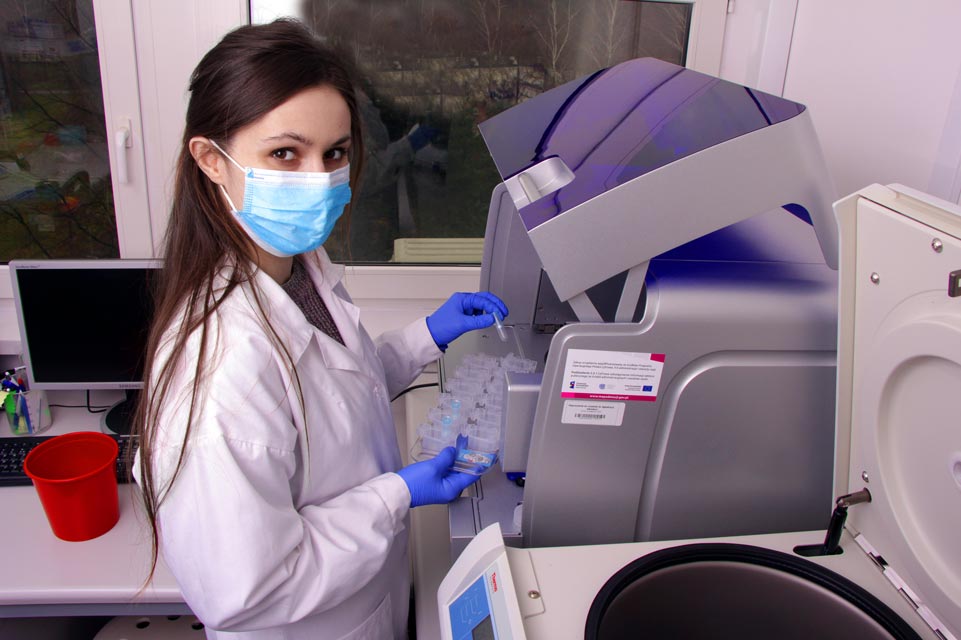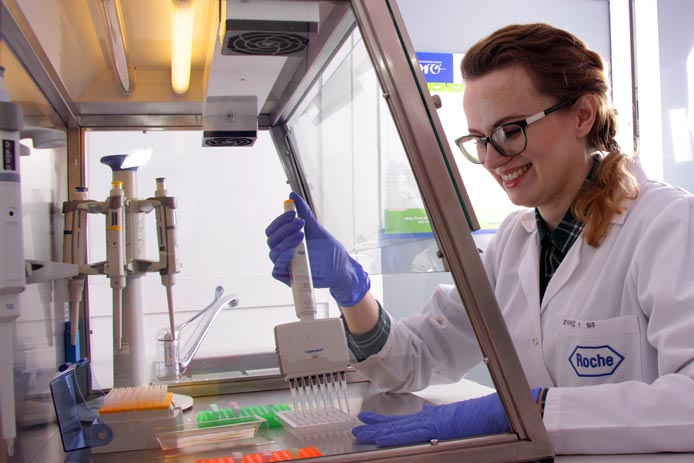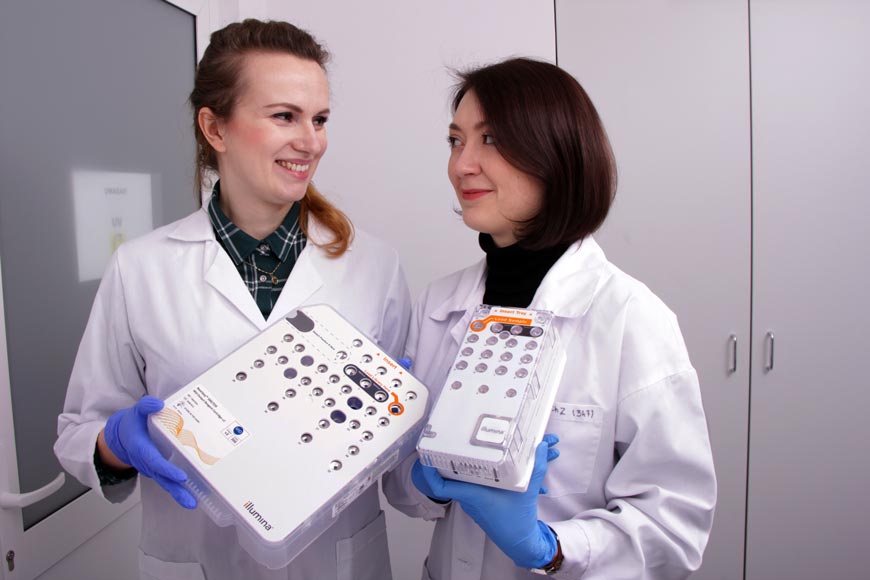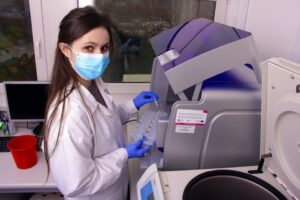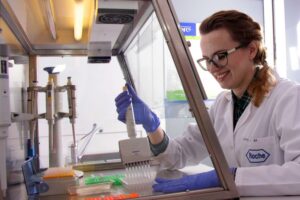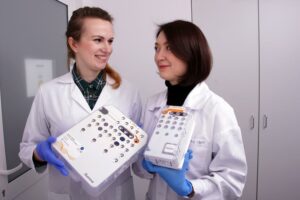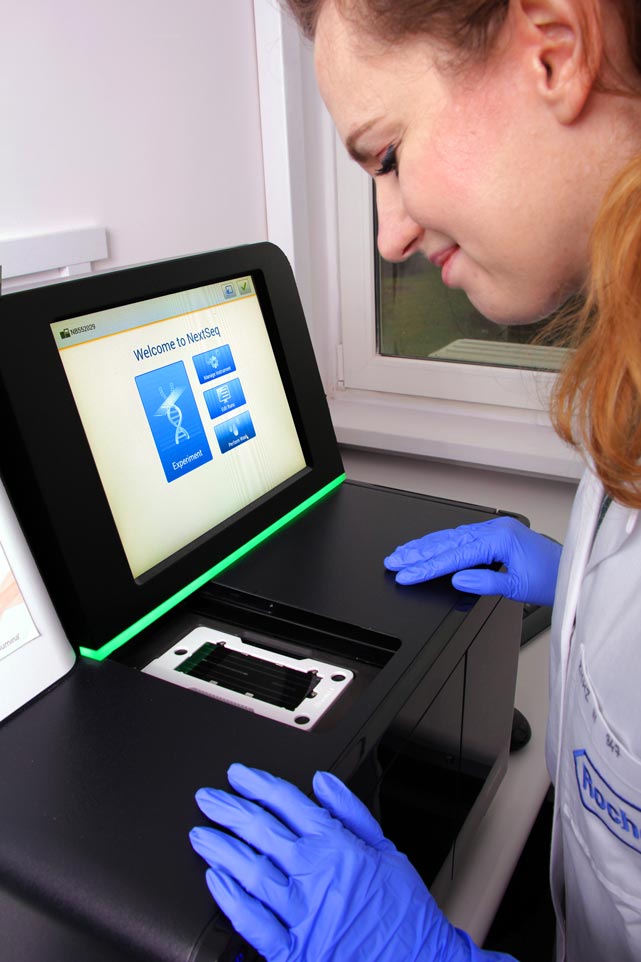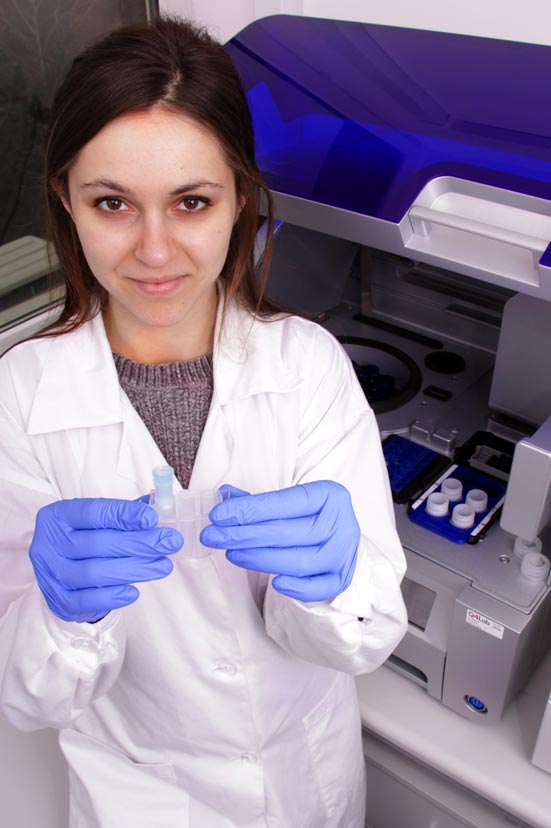Founded in 2019, the laboratory carries out research utilizing high-throughput sequencing of genetic material (NGS). It specializes in developing de novo viral and bacterial genomes and leverages transcriptomic (RNA-Seq) data and artificial intelligence (AI) algorithms to identify molecular markers predictive of anti-cancer treatment responses. Additionally, the team employs AI to identify potential therapeutic targets for immunotherapy. In collaboration with the Institute of Computer Science at Wrocław University of Technology, the lab has developed a deep-learning algorithm capable of determining whether amino acid sequences may be potential toxins or associated with drug resistance. The lab also employs CRISPR-Cas9 gene editing techniques to develop novel therapies for rare diseases and cancer.
Head: Łukasz Łaczmański, PhD, DSc, associate professor IITD (0000-0002-0874-5483)
 Łukasz Łaczmański, DSc specializes in genome analysis using next-generation sequencing (NGS) and is engaged in research on the transcriptomes and genomes of bacteria, viruses, and humans. Dr. Łaczmański leads a research team focused on applying high-throughput sequencing (NGS) and bioinformatics to investigate the molecular basis of microbiomes, rare diseases, and cancer. He is a member of the Wrocław Doctoral School Council and serves on the Board of the Polish Genetic Society. Dr. Łaczmański is an advocate for modern molecular techniques, including next-generation sequencing (NGS), for medical diagnostics. He studies the potential of gene therapy and immunotherapy and he participates in projects related to biosecurity, bioterrorism prevention, and the consequences of biological weapons.
Łukasz Łaczmański, DSc specializes in genome analysis using next-generation sequencing (NGS) and is engaged in research on the transcriptomes and genomes of bacteria, viruses, and humans. Dr. Łaczmański leads a research team focused on applying high-throughput sequencing (NGS) and bioinformatics to investigate the molecular basis of microbiomes, rare diseases, and cancer. He is a member of the Wrocław Doctoral School Council and serves on the Board of the Polish Genetic Society. Dr. Łaczmański is an advocate for modern molecular techniques, including next-generation sequencing (NGS), for medical diagnostics. He studies the potential of gene therapy and immunotherapy and he participates in projects related to biosecurity, bioterrorism prevention, and the consequences of biological weapons.
Next Generation Sequencing Team:
Specialists:
- Dorota Kujawa, MSc (0000-0003-0340-7167)
- Justyna Raczkowska, MSc (0000-0002-3863-4944)
- Katarzyna Romańczuk, MSc (0000-0003-0346-3812)
- Kinga Wrońska
PhD Students:
- Katarzyna Romańczuk, MSc (0000-0003-0346-3812)
- Maciej Powierża, MSc
Bioinformatics Team:
Scientific Staff:
- Dariusz Martynowski, PhD, Eng, Assistant Professor (0000-0001-7617-7716)
Specialists:
- Paweł Karpiński, PhD, DSc (0000-0003-3885-694X)
- Katarzyna Nowis, PhD (0000-0002-0415-0271)
- Anita Brzoza, MSc, Eng (0009-0006-0586-9436)
- Marta Gancarek, MSc, Eng
-
De novo analysis of bacterial and phage genomes.
During the project, DNA libraries of 36 bacterial genomes and two phage genomes were compiled. Sequencing reactions were then performed using second-generation (Illumina MiSeq and NextSeq) and third-generation (MinION) sequencers. The reactions resulted in data files in fastq format. Sequencing quality analysis (FASTQC) was performed for seven genomes, followed by filtering of low-quality reads (Trimming). In the next step, de novo sequence assembly was performed using the Spades tool. We are currently evaluating the quality of sequence assembly and annotation (PatricRast and an in-house algorithm). - Analysis of expression regulators in cancer cells.
The focus of this stage of statutory research was to identify regulators of expression in colorectal cancer (CRC). It is one of the most common cancers and the third leading cause of cancer-related deaths, especially in developed countries. The aim of our project was to evaluate the expression levels of a panel of miRNAs in the serum of patients diagnosed with CRC compared to the serum of healthy patients and to find potential biomarkers. This was based on the analysis of free miRNA. For this purpose, serum was collected from eight CRC patients and four control patients. Using Exiqon diagnostic panels, the expression of 182 free miRNAs was determined. The double delta method was used for analysis, and data were normalised by calculating the Log Ratio (LR). Data were analysed using the principal component method and hierarchical cluster analysis. The miRNA classes miR-34a, miR-7-1-3p, miR-629-5p, miR-574-5p, miR-543, miR-30c, miR-335-3p, miR-136-3p, miR-20b-5p were only found in the serum of colorectal cancer patients. These are potential markers for the occurrence of this disease. Work is currently underway to extend the validation of selected miRNAs. In the next stage, it is planned to extend the study to analyse the effects of the selected miRNAs on the transcriptome of cancer cells. -
Introducing mutations with base editors and predicting off-target mutations in vitro.
In the laboratory, advanced methods have been developed for generating and modifying mRNA constructs encoding the cytosine base editor (CBE) BE3. These techniques enable safe and efficient genetic modifications in in vitro cell cultures. By utilizing electroporation, mutation introduction efficiency can reach up to 80%. Additionally, the incorporation of the enhanced green fluorescent protein (EGFP) gene facilitates easy tracking and selection of transfected cells. Amplicon sequencing of edited sites, combined with automated data analysis using nf-core crisprseq, ensures a reproducible and standardized evaluation of base editor efficiency. Furthermore, an emerging method for predicting off-target mutation sites—leveraging long-read nanopore sequencing (Oxford Nanopore Technologies)—will provide an exceptionally sensitive assessment of genome editing safety.
- NGS sequencing of viral genomes;
- Sequencing of bacterial genomes by NGS;
- Compositional analysis of environmental microbiomes by NGS;
- Amplicon-targeted sequencing
- Transcriptomic analysis;
- WES – whole exome sequencing
- Nanopore long read sequencing (ONT);
- Cell genome modification using CRISPR/Cas9 and Base editors;
- Bioinformatic design of CAR antibodies and receptors;
- Immune repertoire analysis;
- Generation II sequencers:
-
- MiSeq (Illumina);
- NextSeq (Illumina);
- Third generation sequencers:
-
- MinION (ONT);
- GridION (ONT);
- PromethION (ONT);
- RealTime PCR:
-
- Quant Studio 3 (Thermofisher Scientific);
- Gradient thermocycler:
-
- T-100 (Bio-Rad);
- NGS library validation device:
-
- TapeStation (Agilent);
- QUANTUS fluorimeter (Promega);
- Nucleic acid isolation:
-
- QiaCube (Qiagen);
- Computing server.
- 2024-2027 Oral health: A window to improve systemic immune response in AD patients. Awarded by the Alzheimer’s Association Research Grant (AARG) Program. Task Contractor.
- 2023-2029 Development of a therapeutic product based on genetically modified T cells for the treatment of relapsed and refractory forms of plasmocytic myeloma: from production of a CAR receptor DNA vector to phase I/II studies, Medical Research Agency. Task management.
- 2023-2028 Creation and development of an integrated system for the analysis and management of structured clinical and multiomic data based on artificial intelligence in civilisation diseases (2023/ABM/02/00005). Task management.
- 2023-2028 Creation of an Oncology Specialist Centre for Digital Medicine (OnkoSCMC). Task management.
- 2023-2027 Innovative integrated system for field and stationary diagnosis of parasitic, bacterial and viral infections in PKW areas (DIAGNOTROP). Task management.
- 2022-2024 Testing the in vivo efficacy of base and prime editing in primary fibroblasts and in a 3D skin model of dystrophic epidermolysis bullosa. Collaboration with St. John’s Dermatology Department at King’s College London. Co-applicant and task leader.
- 2021-2024 Effect of SARS-CoV-2 virus Spike protein glycosylation on complement system activation. NCN grant, OPUS 20 project titled ‘The effect of glycosylation of Spike protein of SARS-CoV-2 virus on complement activation’. Task contractor.
- 2020-2024 Norwegian Funds – The Process of Coordination and Standardisation in the Field of CBRNE as an Element of Prevention, Preparedness and Response. Task management. Funding awarded. Project in the process of negotiating a partnership agreement.
- 2019-2022 The importance of microflora and colonic barrier permeability in the pathophysiology of schizophrenia – in search of determinants of subthreshold inflammation and metabolic dysregulation. National Science Centre OPUS 17. Task management
- 2018-2021 Database of Scientific Information Supporting Innovative Therapies – BINWIT Measure: 2.3 Digital accessibility and usability of public sector information Sub-measure: 2.3.1 Digital accessibility of public sector information from administrative sources and scientific resources Call number: POPC.02.03.01-IP.01-00-006/17. Task management.
- Mustfa SA, Dimitrievska M, Wang C, Gu C, Sun N, Romańczuk K, Karpinski P, Łaczmański Ł, McGrath JA, Jacków-Malinowska J, Chiappini C.: Porous Silicon Nanoneedles Efficiently Deliver Adenine Base Editor to Correct a Recurrent Pathogenic COL7A1 Variant in Recessive Dystrophic Epidermolysis Bullosa. Adv Mater. 2025 Mar 12:e2414728. https://doi.org/10.1002/adma.202414728
- Sobieraj K, Żebrowska-Różańska P, Siedlecka A, Łaczmański Ł, Białowiec A.: Analysis of microbial community potentially involved in carbon monoxide production in compost and its functional assessment: Utilized pathways, enzymes, and genes.Sci Total Environ. 2025 Mar 10;968:178860. https://doi.org/10.1016/j.scitotenv.2025.178860
- Guri-Lamce, I., Alrokh, Y., Graham, C., Maeshima, R., Rognoni, E., Caley, M., Łaczmański, Ł., Hart, S.L., McGrath, J.A., Jacków-Malinowska, J.: Lipid Nanoparticles Efficiently Deliver the Base Editor ABE8e for COL7A1 Correction in Dystrophic Epidermolysis Bullosa Fibroblasts In Vitro. 2024, Journal of Investigative Dermatology 144, 2314-2317.e3. (https://doi.org/10.1016/j.jid.2024.03.027).
- Paściak M., Pawlik KJ., Martynowski D., Łaczmański Ł., Ciekot J., Szponar B., Wójcik-Fatla A., Mackiewicz B., Farian E., Cholewa G., Cholewa A., Dutkiewicz J.: Discovery of a new bacterium, Microbacterium betulae sp. nov., in birch wood associated with hypersensitivity pneumonitis in woodworkers. Environ Microbiol Rep., 2024, 16(4):e13311. (https://doi.org/10.1111/1758-2229.13311).
- Brooks, I.R., Alrokh, Y., Kazemizadeh, A., Balon, K., Newby, G., Liu, D.R., Łaczmański, Ł., McGrath, J.A., Jacków-Malinowska, J., 2024. Highly efficient biallelic correction of homozygous COL7A1 mutation using ABE8e adenine base editor. British Journal of Dermatology 190, 583–585. (https://doi.org/10.1093/bjd/ljad522).
- Misiak, B., Pawlak, E., Rembacz, K., Kotas, M., Żebrowska-Różańska, P., Kujawa, D., Łaczmański, Ł., Piotrowski, P., Bielawski, T., Samochowiec, J., Samochowiec, A., Karpiński, P.: Associations of gut microbiota alterations with clinical, metabolic, and immune-inflammatory characteristics of chronic schizophrenia. Journal of Psychiatric Research, 2024, 171:152–160. (https://doi.org/10.1016/j.jpsychires.2024.01.036).
- Andrzejczak A., Witkowicz A., Kujawa D., Skrypnik D., Szulińska M., Bogdański P., Łaczmański Ł., Karabon L.: NGS Sequencing Reveals New UCP1 Gene Variants Potentially Associated with MetS and/or T2DM Risk in the Polish Population—A Preliminary Study. Genes., 2023, 14(4):789. (https://doi.org/10.3390/genes14040789).
- Misiak, B., Piotrowski P., Cyran A., Kowalski K., Samochowiec J., Jabłoński M., Plichta P., Łaczmański Ł., Żebrowska P., Kujawa D., Łoniewski I., Kaczmarczyk M.: Gut Microbiota Alterations in Stable Outpatients with Schizophrenia: Findings from a Case–Control Study. Acta Neuropsychiatrica, 2023, no. 3:147–55. (https://doi.org/10.1017/neu.2022.38).
- Karpiński, P., Żebrowska-Różańska, P., Kujawa, D., Łaczmański, Ł., Samochowiec, J., Jabłoński, M., Plichta, P., Piotrowski, P., Bielawski, T., Misiak, B.: Gut microbiota alterations in schizophrenia might be related to stress exposure: Findings from the machine learning analysis. Psychoneuroendocrinology, 2023, 155:106335. (https://doi.org/10.1016/j.psyneuen.2023.106335).
- Kujawa, D., Laczmanski, L., Budrewicz, S., Pokryszko-Dragan, A., Podbielska, M.: Targeting gut microbiota: new therapeutic opportunities in multiple sclerosis. Gut Microbes, 2023, 15(2). (https://doi.org/10.1080/19490976.2023.2274126).
- Kowalski, K., Żebrowska-Różańska, P., Karpiński, P., Kujawa, D., Łaczmański, Ł., Samochowiec, J., Chęć, M., Piotrowski, P., Misiak, B.: Profiling gut microbiota signatures associated with the deficit subtype of schizophrenia: Findings from a case-control study. Progress in Neuro-Psychopharmacology and Biological Psychiatry, 2023, 127:110834. (https://doi.org/10.1016/j.pnpbp.2023.110834).
- Weber-Dąbrowska B., Żaczek M., Łobocka M., Łusiak-Szelachowska M., Owczarek B., Orwat F., Łodej N., Skaradzińska A., Łaczmański Ł., Martynowski D., Kaszowska M., Górski A.: Characteristics of Environmental Klebsiella pneumoniae and Klebsiella oxytoca Bacteriophages and Their Therapeutic Applications. Pharmaceutics., 2023, 28;15(2):434. (https://doi.org/10.3390/pharmaceutics15020434).
- Sheriff, A., Guri, I., Zebrowska, P., Llopis-Hernandez, V., Brooks, I.R., Tekkela, S., Subramaniam, K., Gebrezgabher, R., Naso, G., Petrova, A., Balon, K., Onoufriadis, A., Kujawa, D., Kotulska, M., Newby, G., Łaczmański, Ł., Liu, D.R., McGrath, J.A., Jacków, J.: ABE8e adenine base editor precisely and efficiently corrects a recurrent COL7A1 nonsense mutation. Sci Rep., 2022, 19643. (https://doi.org/10.1038/s41598-022-24184-8)
- Balon K., Sheriff A., Jacków J., Łaczmański Ł.: Targeting Cancer with CRISPR/Cas9-Based Therapy. Int. J. Mol. Sci. 2022, 23(1):573. (https://doi.org/10.3390/ijms23010573).
- Razim A., Pacyga K., Naporowski P., Martynowski D., Szuba A., Gamian A., Górska S.: Identification of linear epitopes on the flagellar proteins of Clostridioides difficile. Sci Rep., 2021, 11(1):9940. (https://doi.org/10.1038/s41598-021-89488-7).
- Batycka-Baran A., Koziol M., Bieniek A., Wolf R., Łaczmański Ł., Szepietowski J.: Expression of koebnerisin (S100A15) and calgranulin A (S100A8) in lesional and perilesional skin in patients suffering from hidradenitis suppurativa. J Eur Acad Dermatol Venereol., 2020, 34(8): 402-404 (https://doi.org/10.1111/jdv.16320).
- Martynowicz H., Gać P., Kornafel-Flak O., Filipów S., Łaczmański Ł., Sobieszczańska M., Mazur G., Porȩba R.: The Relationship Between the Effectiveness of Blood Pressure Control and Telomerase Reverse Transcriptase Concentration, Adipose Tissue Hormone Concentration and Endothelium Function in Hypertensives. Heart Lung Circ., 2020, 29(8): 200-209 (https://doi.org/10.1016/j.hlc.2019.12.012).
- Zagrodna A., Książek A., Słowińska-Lisowska M., Łaczmański Ł.: Calcium-Sensing Receptor Gene Polymorphisms (CASRV1 and CASRV2) and the Physical Activity Level of Men in Lower Silesia, Poland. Front Genet., 2020, 11: 325 (https://doi.org/3389/fgene.2020.00325).
- Szymańska-Chabowska A., Matys T., Łaczmański Ł., Czerwińska K., Janus A., Smyk B., Mazur G., Poręba R., Gać P.: The relationship between PNP, GSTO-1, AS3MT and ADRB3 gene polymorphisms and urinary arsenic concentration among copper smelter and refinery employers. Hum Exp Toxicol. 2020, 39(11):1443-1453 (https://doi.org/10.1177/0960327120925891).
- Filipów S., Łaczmański Ł.: Blood Circulating miRNAs as Cancer Biomarkers for Diagnosis and Surgical Treatment Response. Front Genet., 2019, 10: 169 (https://doi.org/10.3389/fgene.2019.00169).
- Martynowicz H., Kornafel-Flak O., Urbanik D., Łaczmański Ł., Sobieszczańska M., Mazur G., Poręba R., Gać P.: Coexistence of obstructive sleep apnea and telomerase activity, concentration of selected adipose tissue hormones and vascular endothelial function in patients with arterial hypertension. Respir Med., 2019, 153:20-25 (https://doi.org/10.1016/j.rmed.2019.05.009).
- Laczmanski L., Laczmanska I., Lwow F.: Association of select vitamin D receptor gene polymorphisms with the risk of tobacco-related cancers – a meta-analysis. Sci Rep., 2019, 9(1):16026 (https://doi.org/10.1038/s41598-019-52519-5).

